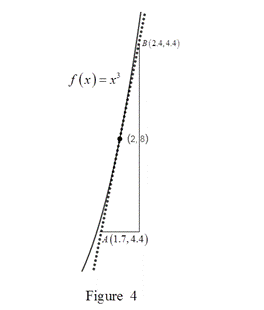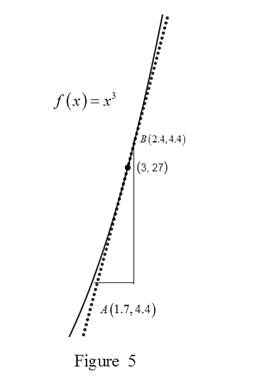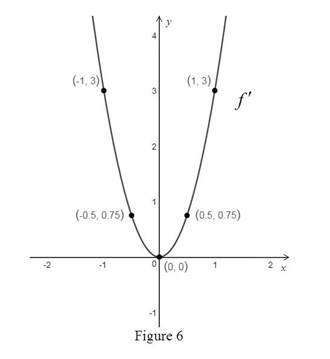
Concept explainers
(a)
To estimate: The value of
(a)
Answer to Problem 18E
The value of
Explanation of Solution
Given:
The function is
Estimation:
Obtain
Use the online graphing calculator to zoom toward the point

The calculation of
From Figure 1, the tangent to the curve at
So,
Thus,
Obtain
Use the online graphing calculator to zoom toward the point

The calculation of
From Figure 2,the slope of the tangent is as follows,
Thus,
Obtain
Use the online graphing calculator to zoom toward the point

The calculation of
From Figure 3, the slope of tangent is,
Thus,
Obtain
Use the online graphing calculator to zoom toward the point

The calculation of
From Figure 4,the slope of tangent is
Thus,
Obtain
Use the online graphing calculator to zoom toward the point

The calculation of
From Figure 5, the slope of tangent is
Thus,
(b)
To deduce: The values of
(b)
Answer to Problem 18E
The values of
Explanation of Solution
Result Used:
For any odd and even function,
Calculation:
The function
Thus, the function
From part (a),
Using the symmetry,
Thus,
Using the symmetry,
Thus,
Using the symmetry,
Thus,
Using the symmetry,
Thus,
(c)
To sketch: The graph of
(c)
Explanation of Solution
Graph:
Use the information from part a and b and sketch the graph of

From Figure 6, it is observed that the function
(d)
To guess: The formula of
(d)
Answer to Problem 18E
The formula of
Explanation of Solution
From part a and part b,
It is observed from the above calculations that the derivative is thrice the square of the input value.
Thus, the formula for the function is,
(e)
To prove: The guess in part d by using the definition of derivative.
(e)
Explanation of Solution
Definition used:
The derivation of a function is given by the formula,
Proof:
Consider the function,
Use the definition of derivative to obtain the derivative of
Simplify the terms in numerator,
Since the limit h approaches zero but not equal to zero, cancel the common term h from both the numerator and the denominator,
So,
Thus, the guess in part d is correct.
Chapter 2 Solutions
Single Variable Calculus: Concepts and Contexts, Enhanced Edition
 Calculus: Early TranscendentalsCalculusISBN:9781285741550Author:James StewartPublisher:Cengage Learning
Calculus: Early TranscendentalsCalculusISBN:9781285741550Author:James StewartPublisher:Cengage Learning Thomas' Calculus (14th Edition)CalculusISBN:9780134438986Author:Joel R. Hass, Christopher E. Heil, Maurice D. WeirPublisher:PEARSON
Thomas' Calculus (14th Edition)CalculusISBN:9780134438986Author:Joel R. Hass, Christopher E. Heil, Maurice D. WeirPublisher:PEARSON Calculus: Early Transcendentals (3rd Edition)CalculusISBN:9780134763644Author:William L. Briggs, Lyle Cochran, Bernard Gillett, Eric SchulzPublisher:PEARSON
Calculus: Early Transcendentals (3rd Edition)CalculusISBN:9780134763644Author:William L. Briggs, Lyle Cochran, Bernard Gillett, Eric SchulzPublisher:PEARSON Calculus: Early TranscendentalsCalculusISBN:9781319050740Author:Jon Rogawski, Colin Adams, Robert FranzosaPublisher:W. H. Freeman
Calculus: Early TranscendentalsCalculusISBN:9781319050740Author:Jon Rogawski, Colin Adams, Robert FranzosaPublisher:W. H. Freeman
 Calculus: Early Transcendental FunctionsCalculusISBN:9781337552516Author:Ron Larson, Bruce H. EdwardsPublisher:Cengage Learning
Calculus: Early Transcendental FunctionsCalculusISBN:9781337552516Author:Ron Larson, Bruce H. EdwardsPublisher:Cengage Learning





